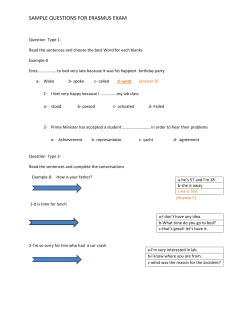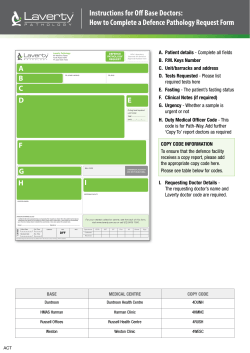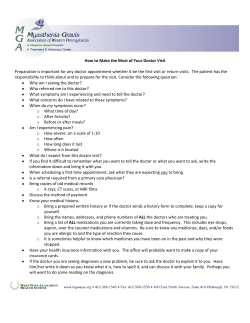
Remote Device Monitoring: Understanding What’s Right For You 1 C9-114-1108
Remote Device Monitoring: Understanding What’s Right For You 1 C9-114-1108 Disclaimer This presentation is provided with the understanding that the slide content must not be altered in any manner as the content is subject to FDA regulation. If portions of the slide presentation are used, the appropriate indications, contraindications, warnings, precautions, and adverse events must be included. 2 Remote Device Monitoring C9-114-1108 Imagine the possibilities • Your doctor may be getting important information from your device while you are relaxing at home. 3 Remote Device Monitoring C9-114-1108 Remote Device Monitoring Overview • Remote Device Monitoring – Factors that determine the type of monitoring you may have – Types of remote device monitoring systems • Trans-telephonic monitoring • Scheduled remote follow-up • Daily/weekly checks – Remote device monitoring systems • The LATITUDE® Patient Management System – An example of a remote device monitoring system 4 Remote Device Monitoring C9-114-1108 What is remote device monitoring? • “Remote" because you don't need to be at your doctor's office to have your device checked. • "Monitoring" because the remote system can check your device for specific information per your doctor’s orders (for example, if the battery status and event information) and as scheduled by your doctor. • How often your device is monitored is determined by your doctor. 5 Remote Device Monitoring C9-114-1108 What is remote device monitoring? All patients should have regular monitoring of their device and health. Why are there so many types of monitoring systems? Three factors determine what type of monitoring system your doctor will prescribe for you: 1. The type of device you have. 2. The manufacturer of your device. 3. What you and your doctor decide is the best approach for you. 6 Remote Device Monitoring Why do I use one monitoring system for my device, while someone else I know uses a different system? C9-114-1108 1. Type of Device You Have • If you have a pacemaker (Pacemaker or CRT-P): – Trans-telephonic monitoring (TTM) offers real-time transmission of heart rate sent over phone line. – In-home remote monitoring as scheduled (manufacturer dependent) offers real-time device and heart data sent over phone line to webbased system. • If you have an implanted cardioverter defibrillator (ICD, CRT-D): – In-home remote monitoring as scheduled by physician with data sent over a secure phone line to web-based system. 7 Remote Device Monitoring C9-114-1108 2. The Device Manufacturer • Each device manufacturer or company uses its own proprietary technology. • One company’s system will not monitor a device from another company. • Some systems allow you to use additional in-home equipment (such as weight scales and blood pressure measurement devices). 8 Remote Device Monitoring C9-114-1108 3. Best Approach for You • You and your doctor will decide what monitoring system is the best for you. 9 Remote Device Monitoring C9-114-1108 Trans-telephonic Monitoring Overview • Trans-telephonic Monitoring (TTM) – Transmits through a standard phone line. – Use of TTM is arranged by your doctor. – Services not typically provided by pacemaker manufacturer. 10 Remote Device Monitoring C9-114-1108 Remote Device Monitoring Overview Common features of remote device monitoring systems include the following: Scheduled Remote Follow-Up • May replace some inclinic follow-ups • Implanted device interrogation at a predetermined time set by your doctor • Checks specific device and heart health information 11 Remote Device Monitoring Daily and Weekly Device Checks • Interrogations between follow-ups • Daily and/or weekly device interrogations set by your doctor • Checks specific device information C9-114-1108 What is a scheduled remote follow-up? • Routine scheduled follow-up: – Gathers data from your implanted device: • Real-time picture of your heart rate (EGM) • Specific information about your device and heart health (manufacturer specific) – Appears on a secure website for review • If you have a wireless system: – The monitor will perform the follow-up automatically. • If you have a wanded system: – You will participate in the followup at the scheduled time. • You may get a note from your clinic before or after your inhome follow-up appointment. • You may get a bill for the inhome follow-up. 12 Remote Device Monitoring C9-114-1108 How are daily and/or weekly checks done? • Your doctor sets a schedule determining when your device will be checked. • Depending on the device you have: – A wireless communicator will automatically receive information, or – You will hold “wand” over your device to allow your monitor to receive your device information. • Information from your device is collected by your monitor then sent by a phone line to your doctor’s secure web site. • Your doctor/nurse then checks your information which they have received. 13 Remote Device Monitoring C9-114-1108 How is information sent? • Most in-home monitoring systems use standard land lines to connect to the internet. – If you have DSL (digital phone lines), you may need an adapter for your phone system. – Some systems use cellular technology. • Keep the monitor connected to a power outlet and a phone line at all times, unless otherwise directed by the manufacturer. 14 Remote Device Monitoring C9-114-1108 What information is checked? • Your doctor will set the monitoring system to check: – Battery status – Leads – Certain device settings – Certain device conditions that need immediate attention 15 Remote Device Monitoring C9-114-1108 What can’t remote monitoring do? • Does not eliminate contact with your doctor. – Always contact your doctor about symptoms you are experiencing. • Does not replace emergency response (911). – Always call 911 or activate EMS for medical emergencies or a change in your health status. • Cannot change device settings. • Does not replace all visits with your doctor. 16 Remote Device Monitoring C9-114-1108 Benefits of remote monitoring • Doctor has access to specific device information. • Doctor can manage your care and respond more efficiently to any health changes communicated by your monitoring system. • System will alert doctor of certain device conditions needing attention. • System is portable if you travel. • Patient support representatives available to assist you in your communications. 17 Remote Device Monitoring C9-114-1108 In an emergency… • Remote monitoring does not replace physician contact! • Always call 911 in an emergency. • Always call your doctor if your health changes suddenly or dramatically. 18 Remote Device Monitoring C9-114-1108 Remote Device Monitoring Systems • Systems commonly available in the US: – Medtronic Carelink® – St. Jude Merlin™@Home and HouseCall Plus™ – Biotronik CardioMessenger® – Boston Scientific LATITUDE® system 19 Remote Device Monitoring C9-114-1108 Remote Monitoring Systems Medtronic CareLink Network • The patient monitor enables you to “connect” your implanted device to your clinic via a standard phone line. • Available for Medtronic ICDs, CRT, pacemakers and implantable cardiac monitors in the United States. www.carelinknetwork.com/ 20 Remote Device Monitoring C9-114-1108 Remote Monitoring Systems St. Jude Merlin@Home • The patient monitor enables you to “connect” your implanted device to your clinic via a standard phone line. • For use with CurrentTM RF ICD and PromoteTM RF CRT-D devices. St. Jude Housecall Plus • The patient monitor enables you to “connect” your implanted device to your clinic via a standard phone line. • For use with AtlasTM and EpicTM ICDs and Atlas HF and Epic HF CRT devices. www.sjm.com/ 21 Remote Device Monitoring C9-114-1108 Remote Monitoring Systems Biotronik CardioMessenger • A portable unit that receives data from the implanted device. It is the link that connects you to the Biotronik service center. • Available for Biotronik ICDs, CRT and pacemakers in the continental United States and in over 50 countries. www.biotronik.com/en/us/ 22 Remote Device Monitoring C9-114-1108 Remote Monitoring Systems Boston Scientific LATITUDE System • The patient monitor enables you to “connect” your implanted device to your clinic via a standard phone line. • Available for Boston Scientific ICDs and CRT devices in the United States, Puerto Rico and the Virgin Islands. www.aboutlatitude.com 23 Remote Device Monitoring C9-114-1108 LATITUDE Patient Management System 1 3 You are implanted with a cardiac device 2 The clinic enters your name into the remote patient management system 4 Clinic receives implant form 24 5 Remote Device Monitoring You set up the equipment at home. 6 Boston Scientific ships equipment to your home Clinic begins managing patients C9-114-1108 LATITUDE Patient Management System When the in-home equipment arrives at your home: • Information to help you set up your equipment: – A video setup guide (in both VHS and DVD formats) – A detailed patient manual – A one-page sheet with instructions and illustrations – LATITUDE Patient Support number • Set up your equipment as soon as you receive it based on manufacturer’s instructions. • After set-up, your doctor can begin monitoring your device. 25 Remote Device Monitoring C9-114-1108 LATITUDE Patient Management System To set up your equipment: • Place your equipment where your sessions will take place, such as by the bedside. • The Communicator plugs into your regular phone line and electrical outlet. • Instructions are provided to guide you through the set-up process. If you have a phone jack in your bedroom, you may want to put the in-home monitor on the nightstand next to your bed. Your doctor decides how often to collect the data, and the remote monitoring system does the rest. 26 Remote Device Monitoring C9-114-1108 LATITUDE Patient Management System • If your in-home equipment is the LATITUDE Wanded Communicator: – A blinking white action button reminds you when it is time to send your information. – Simply hold the wand over your device. – Press the blue interrogation button to send information from your device. – Remote monitoring, on average, takes 10 to 15 seconds to complete but may take more time if additional information needs to be collected. – The Communicator screen will indicate when the session is over. 27 Remote Device Monitoring C9-114-1108 LATITUDE Wanded Communicator Interrogate Button Communicator Wand Action Button Menu Selection Buttons Volume Control 28 Remote Device Monitoring C9-114-1108 LATITUDE Patient Management System • If your in-home equipment is the LATITUDE Wireless Communicator: – It is recommended that your LATITUDE Communicator stay near your bedside. – After it is set up, the Communicator can be configured by your doctor over the phone line. – Your doctor will determine when monitoring will occur. – You typically do not need initiate any action. 29 Remote Device Monitoring C9-114-1108 LATITUDE Wireless Communicator Wireless antenna Interrogate Button Action Button Menu Selection Buttons Volume Control 30 Remote Device Monitoring C9-114-1108 Other in-home monitoring tools • Your doctor may prescribe additional in-home equipment, such as a weight scale and blood pressure cuff, to enhance your follow-up care. • These tools also make it easy for you to take an active role in managing your health. LATITUDE Communicator Wireless weight scale Wireless blood pressure cuff 31 Remote Device Monitoring C9-114-1108 How does this equipment work? • Measure your weight and blood pressure as instructed by your doctor. • Your weight and blood pressure readings are automatically and wirelessly sent to the Communicator. • The Communicator sends this information to a secure computer system that your doctor can access. 32 Remote Device Monitoring C9-114-1108 LATITUDE Patient Management System Think of daily or weekly remote monitoring like a smoke detector. It will only notify you if there is an alert. Would you put the batteries in your smoke detector only once or twice a month? 33 Remote Device Monitoring C9-114-1108 LATITUDE Patient Management System • Ask your doctor about remote monitoring while planning your trip. Some of the scheduled events may need to be temporarily changed. • The in-home monitor may be used while away from home for an extended period of time – just pack it up and take it with you. • The LATITUDE system may be used outside the 50 United States, Puerto Rico and the Virgin Islands. We recommend packing the LATITUDE Communicator in your carry-on luggage. Other monitoring equipment – weight scale and blood pressure cuff – may be checked if well packed 34 Remote Device Monitoring C9-114-1108 Questions? What questions do you have about remote device monitoring? 35 C9-114-1108 Important Safety Information Cardiac Resynchronization Therapy Devices • Cardiac resynchronization therapy pacemakers (CRT-P) and defibrillators (CRT-D) are used to treat heart failure patients who have symptoms despite the best available drug therapy. These patients also have an electrical condition in which the lower chambers of the heart contract in an uncoordinated way and a mechanical condition in which the heart pumps less blood than normal. CRT-Ps and CRT-Ds are not for everyone including people with separate implantable cardioverter-defibrillators (CRT-P only) or certain steroid allergies. Procedure risks include infection, tissue damage, and kidney failure. In some cases, the device may be unable to respond to your heart rhythm (CRT-P only) or may be unable to respond to irregular heartbeats or may deliver inappropriate shocks (CRT-D only). Implantable Cardioverter Defibrillators • An implantable cardioverter defibrillator (ICD) can protect you from the effects of sudden cardiac arrest by reviving your heart rhythm. An ICD is not for everyone, including people with certain steroid allergies. Procedure risks include infection and tissue damage. In some cases, the device may not respond to irregular heartbeats or may deliver inappropriate shocks. Pacemakers • A pacemaker system can monitor and treat your heart rhythm by delivering electrical energy to pace your heart when it senses a slow rhythm. A pacemaker is not for everyone, including patients with certain steroid allergies. Patients who have additional medical conditions that may not allow the pacemaker to function appropriately should not receive a device. Procedure risks include infection, tissue damage and kidney failure. In some cases, the device may not respond to your heart rhythm. For All Devices • In rare cases severe complications or device failures can occur. Electrical or magnetic fields can affect the device. Only your doctor knows what is right for you. These devices are available by prescription only. Individual results may vary. Device Quality and Reliability • It is Boston Scientific’s intent to provide implantable devices of high quality and reliability. However, these devices may exhibit malfunctions that may result in lost or compromised ability to deliver therapy. Refer to Boston Scientific’s CRM product performance report on www.bostonscientific.com for more information about device performance, including the types and rates of malfunctions that these devices have experienced historically. While historical data may not be predictive of future device performance, such data can provide important context for understanding the overall reliability of these types of products. Also, it is important that you talk with your doctor about the risks and benefits associated with the implantation of a device. (Rev. B) 36 Remote Device Monitoring C9-114-1108 Important Safety Information The LATITUDE Patient Management system is used to remotely communicate with a compatible pulse generator device from BSC CRM and send data to a central database. The LATITUDE system is contraindicated for use with any pulse generator other than a device from BSC CRM. The LATITUDE system is designed to tell your doctor within 24 hours if alert conditions are detected by the Communicator. However, alert notification cannot occur if: – The Communicator is unplugged or is not able to connect to the LATITUDE system through an active phone line. – Your device and the Communicator cannot establish and complete a communication session. This session must be initiated by you if you have a device that uses inductive telemetry (Communicator that has a wand). – The Communicator becomes damaged or it malfunctions Up to two weeks may go by before the LATITUDE system detects the events mentioned above, and additional time may be required for notification and resolution of the condition. The wanded and wireless Communicator uses a radio frequency (RF) communication system to communicate with an optional weight scale and blood pressure monitor. This communication can be disrupted by electromagnetic interference. Avoid placing your Communicator next to or in the immediate vicinity of other wireless products and sources of electromagnetic energy. The wireless Communicator uses RF to also send and receive signals from the implanted device (RF enabled devices only). Using the blue Interrogate button more than as prompted by your Communicator or as instructed by your physician may lead to a decrease in the battery life of your implanted device. Your communicator is designed to be used in the continental US, Alaska, Hawaii, and Puerto Rico. These devices are available by prescription only. (Rev. I) 37 Remote Device Monitoring C9-114-1108 Thank you! This presentation was sponsored by Boston Scientific Cardiac Rhythm Management We work to improve the quality of life for cardiac patients and those who care for them. 38 C9-114-1108
© Copyright 2025











